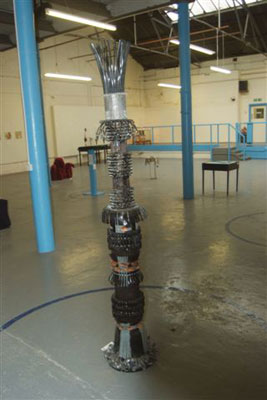
| HOME |
| NERVE |
| REVIEWS |
| ARCHIVE |
| EVENTS |
| LINKS |
| ABOUT US |
| CONTRIBUTORS |
| BACK ISSUES |
| CONTACT US |
 Waste
Into Art
Waste
Into Art
Red Dot Exhibitions
Academy of Arts, Seel Street (17th March – 3rd April 2009)
Reviewed by Val Walsh
Waste is what we don’t value and throw away: ‘rubbish’ we discard as unimportant, bad, faulty, boring, or surplus to need; the excess of modern living in a consumerist culture which coerces us (necessarily) to accept obsolescence as simply part of the process by which capitalist economies keep going, expand and increase their profits. To play our part as consumers, we must be prepared to throw away on a daily basis, and replace our waste with the next gadget or promise of personal and social ‘fulfilment’ or status.
This in turn, is defined as ‘success’. The larger the mountain of waste generated by a society, the greater its claim to consumerist/ capitalist fame and fortune. Waste became the mark of an ‘advanced’ economy during the turbo years of market capitalism and consumerism: the years of exploitation, bury-the-evidence and look-the-other-way. So for the artists in this show, there is no shortage of materials.
The social, environmental and political contexts of this exhibition loom larger by the day: reduce, re-use, recycle, have become desperate mantras for our time, as climate chaos, fiscal crisis and political panic combine to create a nerve-racking armlock on daily lives and social, political and cultural institutions.
At a pivotal historical moment, when waste suddenly looks more like a sign of personal and institutional failure and ignorance, rather than ‘success’ and superiority, the artists of the Red Dot collective provide evidence of how personal and social creativity can work to salvage sense, beauty and wisdom from dereliction and neglect, despair and social vandalism. And they do it with wit and style, achieving work that is by turn sombre, elegant and compelling; delicate, allusive and mysterious; playful, disturbing, even sinister; as well as funny and quizzical. The eclectic nature of the exhibition is part of its strength, and I am moved to make a link between this and thoughts on a national jamboree that lies ahead.
Asked what we should be celebrating in 2012 as we host the Olympic ceremonies. Kathryn Hunter, actor and director, thinks “we can learn a lot from the Chinese ceremonies – their sense of discipline, and of working together” (Guardian, 25th March 2009). What scary rubbish! Artist Grayson Perry, by contrast, suggests we instead “exploit our strengths – our chaotic rebelliousness...We’re the messy creatives”. He proposes “a mass celebration like something for Reclaim the Streets or Critical Mass - somewhere between a carnival and a hippy protest” (ibid.). Artist Jeremy Deller (famous for his film on the 1984 miners’ dispute) makes a similar point: “We need something that reflects the British personality: chaotic, anarchic, satirical’, rather than ‘25,000 soldiers banging on drums” (ibid.).
This Red Dot exhibition is more in the spirit of Perry and Deller’s dreams (and work as artists), than in line with Chinese ‘discipline’ and top-down regimentation, and this should be noted and celebrated. Here, a common starting-point has not resulted in work that toes a single line. Instead it represents the obverse to the authoritarianism and control-freakery of the fundamentalist ethos of, for example, the British National Party, the Israeli Defense Force or the Chinese government. It’s serious and playful.
As well as being a celebration of the transforming power of art, the exhibition asserts diversity and difference as casual virtues. In this, it models social and political possibility. The most ‘unpromising’ materials ( roofing felt, scrap metal and paper, discarded CD cases, domestic debris, found objects and images) surprise the viewer in their refreshed incarnations. Nor are we presented with mere ‘cleverness’ and gimmicks; or objects that simply proclaim: ‘I’m made of rubbish’. These thought-provoking objects and images re-instate the ‘aesthetic’ as central to recovery and renewal (personal, social, environmental, political); prove humour’s place within art; and demonstrate the significance of hybridity, as artists work across the old boundaries of fine art, sculpture, popular culture, domestic arts and assemblage.
Waste Into Art displays the improvisational skills and artistry needed (in life as much as art), if we are to move beyond wasting (away), towards sustainable behaviour and endurance. The fact that only one contributor ‘recycles’ the (silly, offensive and ill-executed) cliché of pink, painted female nudes as muse/art - and that these images look so out of place in this artistic company - is, I suppose, a mark of progress.